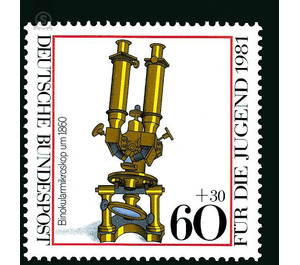Youth 1981 Optical Instruments - Germany / Federal Republic of Germany 1981 - 60 Pfennig
| Country | Germany / Federal Republic of Germany |
| Issue Date | 1981 |
| Face Value | 60.00 |
| Color | brown white |
| Perforation | K 14 |
| Printing Type | Six-color offset printing |
| Stamp Type | Postage stamp |
| Item Type | Stamp |
| Chronological Issue Number | 965 |
| Chronological Chapter | GER-BRD |
| SID | 17338 |
| In 27 Wishlists | |
The youth stamps will be issued in favor of the »Deutsche Jugendmarke e.V. Foundation«. It promotes measures for the benefit of German youth with the contract proceeds. This year's youth brand series shows historical optical instruments, presented after collection pieces from the Deutsches Museum, Munich. The Capuchin friar, Father Cherubin d'Orléans, wrote in 1677: "... a few years ago, I came to my conclusion on how to bring a microscope, with which one can grasp the smallest objects simultaneously with both eyes, to a successful conclusion." However, it would take more than 150 years for this invention to be put into practice for practical use. In 1838, English physicist and inventor Sir Charles Wheatstone published a treatise on the stereoscope. The chemist John Leonard Riddell from Louisiana / USA managed to build a truly usable binocular microscope in 1852. The philosopher's binocular microscope was built around 1860 in Paris by the company Nachet & fils.


